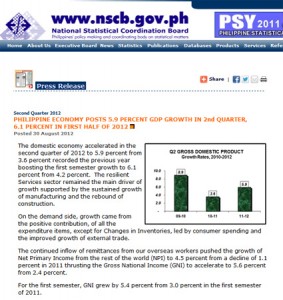Philippine economy grew 5.9% in 2nd quarter

The Philippine economy expanded 5.9 percent in the second quarter of the year, weaker than the revised 6.3 percent recorded in the first three months, as exports slumped and agriculture slowed.
The growth rate was the weakest since the first quarter of 2009, highlighting the tremendous pressure building on export-reliant Asian economies from China and Japan to Southeast Asia to ramp up public spending or further ease monetary policy to shore up activity as the global malaise drags on.
Still, the growth rate was among the highest in the region. Compared with neighboring economies, the second-quarter growth was higher than Malaysia’s 5.4 percent, Thailand’s 4.2 percent, Vietnam’s 4.7 percent and Singapore’s 2 percent, but lower than Indonesia’s 6.4 percent and China’s 7.6 percent.
“It’s clear that something really bad happened in the global economy in the second quarter and we’re seeing poor June and July numbers, especially for regional exports,” said ING economist Tim Condon.
Consumption-driven
“But if we look at first-half growth it was pretty solid … I don’t think this (the Q2 number alone) indicates a structural hit to the Philippine growth story,” Condon said, adding it was difficult at first glance to determine a clear reason for the quarter’s marked weakness.
Malacañang raved about the growth in the second quarter.
“We’re very happy with the 5.9-percent economic growth. Number one, it exceeded the market expectations. The consensus says it was about 5.3 percent,” Communication Secretary Ricky Carandang said at a briefing in Malacañang.
The economy could have contracted if not for a pick-up in consumer spending. Household consumption grew 1.4 percent in the quarter, accelerating from 0.9 percent in the first quarter thanks to strong remittances from Filipinos working overseas.
Economic Planning Secretary Arsenio Balisacan said the second-quarter growth was mainly due to accelerated public investment and a recovery in capital formation.
“The brighter economic outlook supported by increased confidence, strong employment creation and accelerated government spending all contributed to the continued resurgence in economic activities from a moderate growth of 3.6 percent in the same period in 2011,” Balisacan said.
Government spending on public construction from April to June grew 45.7 percent year on year while capital formation rose 2.3 percent from a decline of 10.5 percent in the same period last year, he said.
Key driver
The services sector remained the key driver of growth in the second quarter, contributing 4.3 percentage points, the National Statistical Coordination Board (NSCB) said.
It was followed by industry with 1.5 points and agriculture, hunting, forestry and fishery with 0.1 point, Lina Castro, officer in charge of the NSCB Office of the Secretary General, said at a briefing.
The farm sector accounts for about one-fifth of the economy, and a series of severe storms which lashed the country in July and August could put further pressure on farm output.
Indicators supporting economic growth in the second quarter included employment which increased 2.8 percent, tourist arrivals which rose 7 percent and overseas Filipino workers’ remittances which climbed 4.8 percent.
On a quarterly basis, the economy expanded just 0.2 percent in the second quarter from the first three months of the year, dragged down by a slump in electronics exports and a related drop in industrial output, along with weaker growth in the agriculture and service sectors.
In June, exports slowed sharply from a year earlier, as global demand sputtered, with electronics shipments declining for a third consecutive month.
That weighed heavily on industrial output, which fell a sharp 2.4 percent in the second quarter from the first, when it grew 3.8 percent.
The mining sector posted a negative growth in the second quarter.
Higher than forecast
Balisacan said the second-quarter growth was an acceleration from the 3.6 percent posted in the same period last year and above the average market forecast of 5.3 percent.
The second-quarter figure brought the gross domestic product (GDP) growth for the first semester to 6.1 percent, slightly above the government’s 5 to 6 percent GDP growth target for the year.
The GDP, a measure of the country’s economic health, is the value of goods produced and services rendered in a given period.
The higher end of the government’s GDP growth target is well-within reach, said Balisacan, who is also director general of the National Economic and Development Authority.
“We are not revising. We are not changing the growth target for the year of 5 to 6 percent,” he said.
A threat to growth, according to Balisacan, is the further weakness of a struggling world economy, with the slowdown in China dragging global growth.
He said the lingering Euro crisis and geopolitical uncertainties were also external risks which could result in surging oil prices.
Most resilient economy
Despite the growing chill from the global slowdown, analysts still believe that much of Southeast Asia is better positioned to ride out global turmoil due to their large populations’ spending power, relatively low public and private sector debt and recent efforts to strengthen their financial systems.
In particular, analysts single out Indonesia and the Philippines as perhaps the most resilient economies in the region, followed by Malaysia and possibly Thailand.
“For the rest of (Southeast Asia), especially for the open economies, they would probably be seeing a bit of a slowdown in the second half because exports have been increasingly weak,” said Euben Paracuelles, an economist at Nomura in Singapore.
“For the Philippines, this will also be the case but there’s a bigger offset from domestic demand because investments will hold up.” With reports from Michelle V. Remo, Doris C. Dumlao, and Riza T. Olchondra
Originally posted at 10:46 am | Wednesday, August 30, 2012
